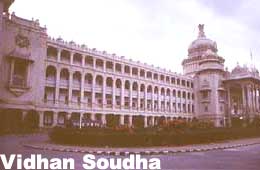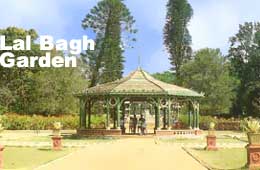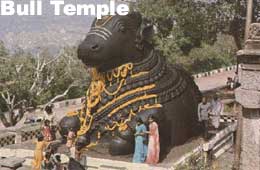| India Profile » Monuments and Temples in India » Monuments in Bangalore | |
Monuments in Bangalore | |
 | |
|
The town of Bangalore was founded in 1537 AD by a Yelahanka Prabhu chieftain, Kempegowda. He was given the land as a gift by a Vijayanagara emperor. Kempegowda constructed four watchtowers to mark the future boundaries of the city. Under the Tipu Sultan and the Wodeyars, Bangalore grew far beyond its watchtowers and prospered into one of Asia's fastest growing cities. Bangalore boasts of number of parks, gardens, lakes and tree-lined avenues making it popular as the "Garden city". Bangalore experiences a moderate climate all round the year because of its elevation. It is situated at an altitude of 3,250 ft above the sea level. The mean temperature remains 27.1 C (80.8 F) in the warmest month of April and 20.48 C (68.8F) in the coldest month of January. Bangalore has a number of tourist attractions worth visiting in the city as well as around it. The tourist places have significant historical and religious value along with the contemporary interests. The Vidhan Soudha, situated at Dr Ambedkar Veddi Road, was built between the years 1954 and 1958. It is a beautiful building and one of the major centers of attraction in Bangalore. The architectural style of the building is based on the neo Dravidian style. It currently houses the State Legislative Assembly and the Secretariat of the state of Karnataka. On the opposite side of the Vidhan Soudha is another public building, the High court of Karnataka. It is a red brick building built in 1885. The Cubbon Park is situated in the center of the Bangalore city. Sir Richard Sankey, the chief engineer of Mysore planned the park and was named after Lord Cubbon, the Commissioner of Bangalore, in the year 1864. The park is spread over an area of about 300 acres and the layout of the park is absolutely beautiful. The Attara Kacheri, the central library, the aquarium, the Jawahar Bal Bhavan with its mini theatre and toy train, the museum, VITM and KSLTA tennis court are with in the premises of the Cubbon Park. The Bangalore Palace was built in 1887 by a Wodeyar king. The architecture of the palace is inspired by the Windsor Palace and based on the Tudor style. It covers an area of about 800 acres and the interiors are done with elegant woodcarvings. The palace is situated in the middle of the Bangalore city and is easily accessible by the tourists. The Palace and the Fort of Tipu Sultan are situated at the Albert Victor Road and provides you an insight into the Mughal life style. The construction of the Tipu palace was started by Haider Ali and completed by Tipu Sultan himself in 1789. The palace has battlements and turrets, Gothic windows and foiled windows resembling the Daria Daulat Palace of Srirangapatnam. The double-storeyed lavishly ornamented palace is made of wood and is known for its carving and paintings. The walls and ceilings are painted in bright colors with carvings. The building now days are used as exhibition hall of the photographs of Tipu and his era. Venkatappa Art Gallery is a pleasant and inviting for the art lovers. The gallery has about 600 paintings on display all through the year. The art gallery also has some of the exclusive collections of scenic displays.
Ulsoor Lake is a perfect gateway for picnics or excursions. It is surrounded with picturesque islands. This pretty picnic spot is on the northeastern fringe of the city center. One can enjoy boat ride or swim in the near by pool. One of Kempegowda's watch towers stand near by. The Nehru Planetarium has a seating capacity of 200 and conducts special shows for schools. The lectures and shows on astronomy are a regular features. Opposite to Nehru Planetarium is a new attraction the "Musical Dancing Fountain". The Bull temple is one of the oldest temples in the city. Kempegowda, who founded the city of Bangalore, built the temple in 1786. The temple is built in typical Dravidian style and has a mammoth, monolithic bull measuring 15 ft in height and 20 ft in length. The temple is made of gray granite polished with a mixture of charcoal and groundnut oil. It is believed by the locals that it has grown in size since the time it was build and now measures nearly 5 meters in height and 6 meters in length. The temple is dedicated to Nandi, the mount of the Lord Shiva. The International Society for Krishna Consciousness or ISKCON Temple Complex of Bangalore is a marvelous building structure. It is harmonious blend of the Dravidian and modern architecture. The main temple hall houses the altars of Their Lordships Sri Radha Krishna-Chandra, Sri Krishna Balarama and Sri Nitai Gouranga. You will find the Golden Chandelier shaped like an inverted Lotus Flower. The building possesses some of the modern facilities like the multi-vision cinema theatre, computer aided presentation theatres along with Vedic library and a preaching library. The temple also has good accommodation facility for its members and non-members.
The Statue of Shiva is a 65 feet high depiction of Lord Shiva in the Padmasana mudra or the Lotus position. The statue is depicts the Mount Kailash, the Lord's heavenly abode and the river Ganga flowing from his matted locks in the background. The entire area gives you a clear picture of the mythological legend related to it. The Aquarium is the second largest in the country. It is built in a well-planned manner and has a good collection of a variety of aquatic life. Visveswaraiah Industrial and Technological Museum is a place for information on science and technology. The museum has various technological gadgets, working model and diagrams and displays. The museum is dedicated to the memory of Sir. M. Visveswaraiah. Government Museum is situated at Kasturba Gandhi Road near the Cubbon Park. It is one of the oldest museums of the country and was opened in 1886. It has 18 galleries including Neolithic finds from the Chandravalli excavations and from the Indus valley, especially Mohanjedaro antiquities. The museum also exhibits the antique jewelry, textiles, coins and miniature paintings. |
|
 |
 Thee is a story about how Bangalore got its name from a modest meal of boiled beans. Once a kind woman gave a meal of boiled beans to the lost and starved king of the Vijaynagar Empire. After that, the king called the place Bendakaaluooru, which is a combination of two Kannada words 'Benda Kaalu' which means 'boiled beans' and 'Ooru', which means 'village'. Bendakaalooru gradually became Bengalooru and Bangalore in English.
Thee is a story about how Bangalore got its name from a modest meal of boiled beans. Once a kind woman gave a meal of boiled beans to the lost and starved king of the Vijaynagar Empire. After that, the king called the place Bendakaaluooru, which is a combination of two Kannada words 'Benda Kaalu' which means 'boiled beans' and 'Ooru', which means 'village'. Bendakaalooru gradually became Bengalooru and Bangalore in English.  This Lal Bagh Garden is situated at the Lal Bagh Fort Road. The 100 ha Botanical garden was laid out by Haider Ali in 1760. Tipu Sultan added a several exotic plants and trees brought over from many countries. It was originally called Lalbagh because the garden had plenty of red roses. It also has a very good collection of tropical and sub tropical and medicinal plants. The Glass House, inspired by the London Crystal Palace, is the main attraction of the park. It is built in 1881 and displays major variety of flowers in the week before the Republic day and the Independence day. The gardens are open every day from sunrise to sunset. The entry is free during flower shows. The Bal Bhavan is a children park with pony rides, boat rides, toy train rides and other attractions. The Rose garden is another attraction at Lal Bagh garden. It is placed at the heart of the Lal Bagh, near to north gate entrance. 150 different kinds of roses are grown here.
This Lal Bagh Garden is situated at the Lal Bagh Fort Road. The 100 ha Botanical garden was laid out by Haider Ali in 1760. Tipu Sultan added a several exotic plants and trees brought over from many countries. It was originally called Lalbagh because the garden had plenty of red roses. It also has a very good collection of tropical and sub tropical and medicinal plants. The Glass House, inspired by the London Crystal Palace, is the main attraction of the park. It is built in 1881 and displays major variety of flowers in the week before the Republic day and the Independence day. The gardens are open every day from sunrise to sunset. The entry is free during flower shows. The Bal Bhavan is a children park with pony rides, boat rides, toy train rides and other attractions. The Rose garden is another attraction at Lal Bagh garden. It is placed at the heart of the Lal Bagh, near to north gate entrance. 150 different kinds of roses are grown here. 